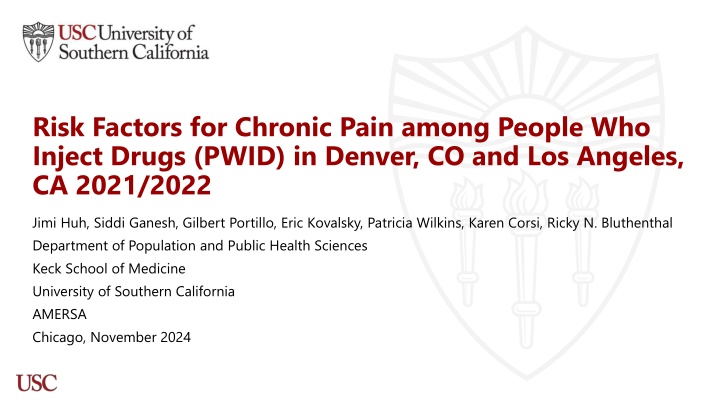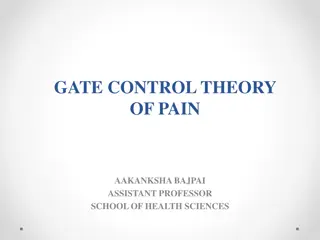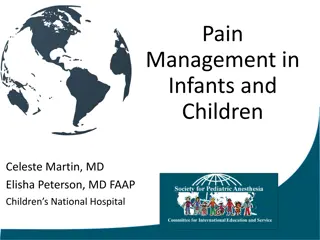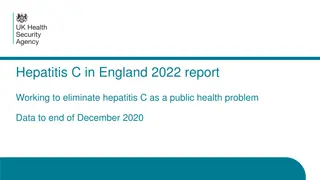
Risk Factors for Chronic Pain Among People Who Inject Drugs in Denver, CO and Los Angeles, CA
Chronic pain is prevalent among individuals who inject drugs, impacting their healthcare experience. This study delves into factors influencing chronic pain in opioid-using persons, shedding light on violence exposure, injection practices, mental health diagnoses, and pain severity.
Download Presentation

Please find below an Image/Link to download the presentation.
The content on the website is provided AS IS for your information and personal use only. It may not be sold, licensed, or shared on other websites without obtaining consent from the author. If you encounter any issues during the download, it is possible that the publisher has removed the file from their server.
You are allowed to download the files provided on this website for personal or commercial use, subject to the condition that they are used lawfully. All files are the property of their respective owners.
The content on the website is provided AS IS for your information and personal use only. It may not be sold, licensed, or shared on other websites without obtaining consent from the author.
E N D
Presentation Transcript
Risk Factors for Chronic Pain among People Who Inject Drugs (PWID) in Denver, CO and Los Angeles, CA 2021/2022 Jimi Huh, Siddi Ganesh, Gilbert Portillo, Eric Kovalsky, Patricia Wilkins, Karen Corsi, Ricky N. Bluthenthal Department of Population and Public Health Sciences Keck School of Medicine University of Southern California AMERSA Chicago, November 2024
DISCLOSURES No disclosure
Introduction Chronic pain is common among people who inject drugs (PWID) Approximately half of study samples A majority used drugs to manage pain Pain described as usual part of life rather than disruption Request for pain relief is often disregarded by healthcare providers due to concerns about misuse4 5 Inadequate pain management is a barrier to needed care across the life course for people with opioid use disorder
Objectives of the study To describe chronic pain among a sample of opioid-using people who inject drugs (PWID) To examine factors associated with chronic pain Experiencing violence, injection behaviors and history, and mental health diagnoses To investigate factors associated with more severe pain and disability among PWID Experiencing violence, injection behaviors and history, and mental health diagnoses
Methods Opioid using PWID were interviewed during 2021/2022 in Denver, CO and Los Angeles, CA (N=472) Behaviors were assessed in the last 3 months Recruitment occurred in community settings associated with syringe service programs (in both LA & Denver) and other service providers (methadone program & shower facility in LA only)
Outcome variables Chronic pain in the last 3 months "In the last 3 months, have you experienced any chronic or ongoing pain due to an injury or other ailment (like arthritis or migraine headaches, but not counting withdrawal symptoms)?"
Outcome variables Chronic Pain Grade Questionnai re Smith, B.H., Penny, K.I., Purves, A.M., Munro, C., Wilson, B., Grimshaw, J., Chambers, W.A., Smith, W.C., 1997. The Chronic Pain Grade questionnaire: validation and reliability in postal research. Pain 71(2), 141-147.
CPG classifications Outcome variables "Allows for patients with chronic pain to be classified according to the severity of their pain and the way it interferes with their daily functioning."
Independent variables and co-variates Substance use patterns for heroin, methamphetamine, cocaine, goofball, speedball, non-prescribed use of medications (opioids, stimulants, sedatives, and tranquilizers), and cannabis Route (injection & non-injection) Frequency by route in the last 3 months Experiences with violence (6 items) Threatened with weapon; Punched; Attacked with weapon; Sexual coercion; Attacked by stranger; and Belongings stolen Covariates Demographic and socioeconomic characteristics, including housing
Analyses Any chronic pain in the last 3 months (N=472) Multivariable logistic regression Chronic pain grade classification (n=255) Multinomial logistic regression IVs = Experience with violence, mental health diagnoses, drug use history and behaviors
Results: Demographic and socioecononmic characteristics (N=472) Race/ethnicity 23% female or transgendered 50% under 40 years old 53% reported monthly income <$1,000 84% unhoused/unstably housed Non-Hispanic White 6% 6% Hispanic 10% American Indian 52% Black 26% Other
Drug use and routes in the last 3 months (n=472) Variable Percent Variable Percent Any opioid use Heroin Fentanyl Non-prescribed pills Injection frequency Less than daily 1 to 2 times a day 3 or more times a day 82% 70% 28% 30% 20% 50% Any methamphetamine 84% Non-injection frequency Any crack cocaine 33% None 3% Any goofball 63% Less than daily 28% Any speedball 29% 1 to 2 times a day 29% Any cannabis 75% 3 or more times a day 40%
Pain, health, and violence characteristics (N=472) Variable % Any chronic pain (yes=1) 51% Any mental health diagnosis ever (yes=1) 67% Chronic Pain Grade Grade 0 49% Grade I 3% 19% 33% 24% 25% Grade II 15% Grade III 14% Grade IV 19% Violence exposure/experiences None 19% 1 33% 2 or 3 24% 4 or more 23%
Any chronic pain in the past 3 months as outcome (N=470) Adjusted OR (AOR) 95% CI Experiencing violence, last 3 months No violent events (ref) One violent event 2 or 3 violent events 4 or more violent events Injection history (in years) <10 years of injection (ref) 10-20 years of injection 20+ years of injection Mental health diagnosis Yes Controlling for Latinx ethnicity. -- -- 1.04 2.11 3.48 0.59-1.86 1.14-3.88 1.83-6.60 -- -- 0.79 2.16 0.48-1.28 1.33-3.51 1.67 1.10-2.52
Factors associated with chronic pain classification among those reporting chronic pain (n=245) Grade II (30%)a Grade III (26%)a Grade IV (38%)a AOR (CI) AOR (CI) AOR (CI) Experiencing violence No violent events (ref) -- -- -- One violent event 0.30 (0.03-3.01) 0.60 (0.06-6.51) 0.63 (0.06-6.41) 2 or 3 violent events 0.15 (0.02-1.30) 0.23 (0.02-2.25) 0.10 (0.01-0.91) 4 or more violent events 1.57 (0.09-27.55) 3.51 (0.19-65.01) 2.81 (0.16-49.61) Injection frequency < daily (referent) -- -- -- 1 or 2 times a day 1.24 (0.34-4.55) 1.67 (0.44-6.40) 1.47 (0.39-5.76) 3 or more times a day 5.80 (1.12-30.1) 9.54 (1.80-50.69) 12.18 (2.33-63.76) aReference category: Chronic pain severity Grade I (6%)
Limitations Self-report data. Reliability may be a concern, although other studies have found good reliability and validity of measures6,7 Cross-sectional analysis; causality cannot be established.
Conclusions Chronic pain is prevalent among PWID. High pain intensity and disability, as captured in the chronic pain grade classification, is common for those with chronic pain. A third of participants had disabling chronic pain. Injection frequency/history is associated with any chronic pain and severity of pain
Discussion More research that is focused on disentangling injection frequency (e.g., self-medication/pain management) vs. injection as cause of injury is needed8 Structural interventions that impact the intersectional risk environment such as housing, violence prevention and intervention, and harm reduction services are indicated to manage chronic pain in this population.
References 1. Bicket, M. C., Park, J. N., Torrie, A., Allen, S. T., Weir, B. W., & Sherman, S. G. (2020). Factors associated with chronic pain and non-medical opioid use among people who inject drugs. Addictive Behaviors, 102, 10617 2. Dahlman, D., Kral, A. H., Wenger, L., Hakansson, A., & Novak, S. P. (2017). Physical pain is common and associated with nonmedical prescription opioid use among people who inject drugs. Substance Abuse Treatment, Prevention, and Policy, 12, 1-11; 3. Dassieu, L., Kabor , J. L., Choini re, M., Arruda, N., & Roy, . (2020). Painful lives: Chronic pain experience among people who use illicit drugs in Montreal (Canada). Social Science & Medicine, 246, 112734. 4. McNeil, R., Guirguis-Younger, M., 2012. Illicit drug use as a challenge to the delivery of end-of-life care services to homeless persons: perceptions of health and social services professionals. Palliat Med 26(4), 350-359. 5. Mayer, S., Langheimer, V., Nolan, S., Boyd, J., Small, W., McNeil, R., 2023. Emergency department experiences of people who use drugs who left or were discharged from hospital against medical advice. PLoS One 18(2), e0282215PMC9949621. 6. Smith, B.H., Penny, K.I., Purves, A.M., Munro, C., Wilson, B., Grimshaw, J., Chambers, W.A., Smith, W.C., 1997. The Chronic Pain Grade questionnaire: validation and reliability in postal research. Pain 71(2), 141-147. 7. Weatherby, N., Needle, R.H., Cesari, H., Booth, R., McCoy, C.B., Watters, J.K., Williams, M., Chitwood, D.D., 1994. Validity of self-reported drug use among injection drug users recruited through street outreach. Evaluation and Program Planning 17, 347-355. 8. Ceasar, R.C., Goldshear, J.L., Brothers, S., Wenger, L.D., Kral, A.H., Bluthenthal, R.N., 2021. Factors associated with injury and blood-borne infection risk when providing assisted injection among people who inject drugs. Int J Drug Policy 97, 103297.






















